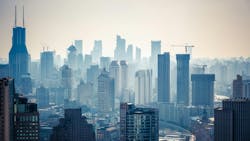Densely placed buildings and hard surfaces producing intense heat are urban heat islands. For example, a metropolitan area that is much warmer than the surrounding rural areas is an urban heat island, or UHI. The Environmental Protection Agency’s webpage on Heat Islands states that “buildings, roads, and other infrastructure absorb and re-emit the sun’s heat more than natural landscapes such as forests and water bodies.” With limited greenery and highly concentrated buildings, urban areas become islands compared to the surrounding areas.
New York City is an example of an urban heat island. The EPA states that the annual air temperature for a city with a population of 1 million people can be 1.8-5.4 degrees Fahrenheit warmer than its surroundings. On average, urban cities experience daytime temperatures about 1-7 degrees F. higher than the surrounding areas and nighttime temperatures about 2-5 degrees F. higher.
What are Heat Island Factors?
UHIs can form because of numerous factors: limited natural landscape, construction materials and dense construction practices, human activities, and weather and geography.
Limited natural landscape
Urban areas’ hard, dry surfaces—roofs, sidewalks, buildings, parking lots and roads —provide less shade and moisture compared to trees, vegetation and water bodies that cool the air through the shade, transpiring water from plant leaves and surface water evaporation.
Construction materials
The climate within UHIs is typically warmer, even at night. The buildings, sidewalks and parking lots prevent the heat from the ground from rising into the atmosphere, maintaining warmer temperatures on the surface. Roofing and pavement typically reflect less solar energy and absorb and emit more heat than natural surfaces.
Dense construction practices
Large cities have limited square footage, requiring contractors to build skyscrapers. Construction generates waste heat, and heat that escapes insulation lingers in and between buildings within the UHI. Heavily populated areas typically generate more heat. When houses, shops and industrial buildings are built close together, it can create urban canyons that block natural wind flow to cool the city. Building materials can be good sources of insulation that retain heat, making areas beside buildings warmer.
Heat generated from humans
People exercising, vehicles, buses and trains, industrial facilities, air conditioners and buildings emit heat into the atmosphere. This anthropogenic waste heat contributes to UHIs.
Weather and geography
Weather conditions can affect the presence and severity of urban heat islands. Calm and clear conditions can create more severe heat islands because they maximize the solar energy reaching the surfaces. Strong winds and clouds can suppress heat island formation. Mountains can block wind or help channel winds through a city.
Urban areas warmer temperatures can put pressure on the grid during summertime. As people crank up their air conditioners, the increased demand can force utility companies to do rolling blackouts or lead to power outages. Thus, turning on the air conditioner or electric fans exacerbates the heat produced within the UHI.
Such energy consumption can be costly to cities. The Heat Island Group reported that Los Angeles’ urban heat island costs the city $100 million annually in energy.
In addition to warmer temperatures, UHIs can have worse air and water quality because of the quantity of pollutants from people, vehicles and industry entering the atmosphere. The warmer climate also increases water temperature that flows into local waterways which stresses the native species that adapted to cooler ecosystems.
How Can You Address an Urban Heat Island?
The implications of urban heat islands can affect the environment, the livelihoods of residents and visitors and cost government agencies millions of dollars. So, how can the impact of an urban heat island be lessened?
Installing green roofs, covering a building’s roof in plants, can drop the temperature and absorb carbon dioxide trapped in the UHI. Planting trees and vegetation cover decreases surface and air temperatures as the plants offer shade and cooling through evapotranspiration. Trees and vegetation are also great erosion mitigators from stormwater runoff.
Light-colored buildings can also help as the light colors reflect sunlight and retain less heat. Using building and paving materials or coatings that reflect sunlight can cool the surface and air and reduce temperatures inside buildings.
About the Author
Lauren Brant
Buildings Editor
Lauren Brant is the editor of Buildings. She is an award-winning editor and reporter whose work appeared in daily and weekly newspapers. She strives to create content that is informative and actionable for professionals, helping them discover new products, technology, and insights to make smarter building decisions. In 2020, the weekly newspaper won the Rhoades Family Weekly Print Sweepstakes—the division winner across the state's weekly newspapers. Lauren was also awarded the top feature photo across Class A papers. She holds a B.A. in journalism and media communications from Colorado State University-Fort Collins and a M.S. in organizational management from Chadron State College.

